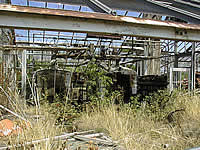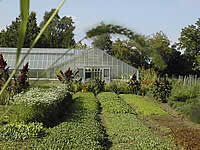Waste Site Cleanup & Reuse in New England
Urban Oaks Organic Farm
Success in EPA Brownfields Assessment Grant Program
New Britain, CT
(September 10, 2003)
Contacts
|
||||||
The city of New Britain, CT received $200,000 in 1997 from the EPA New England Brownfields Assessment Pilot program to conduct environmental site assessments on properties in the community. The city spent $39,512 to assess the former Sandelli Greenhouses, Inc. (Sandelli) properties and two adjacent properties. In June 2003, the City was awarded an EPA Brownfields Cleanup Grant for $60,000 to begin cleanup of the abutting 207 Oak Street property, a former gas station and auto repair shop. The Sandelli property at 233 Oak Street has been redeveloped into the Urban Oaks Organic Farm. The adjacent 207 Oak Street parcel, a former gas station and auto repair operation, will eventually become a part of the farm as a year round retail outlet. The urban organic farm provides education for the city residents and school groups in organic gardening methods, sustainable agriculture, non-toxic farming techniques, composting, and other environmentally-friendly farming techniques.
Odolfo Sandelli emigrated from Northern Italy and opened a flower and produce stand in New Britain, CT. He grew the business into a horticultural product distribution operation which he ran until his death in 1977 at the age of 88. At it’s peak, the business operated seven enormous greenhouses over 4 acres. The family attempted to keep the business going, but it closed in 1983 and sat abandoned and largely forgotten until two local farmers, Michael Kandefer and Tony Norris, rediscovered this resource and had the vision of converting the property into an urban oasis for organic farming and agriculture education.
Sandelli Greenhouses, Inc. consisted of four properties: 212, 218, 222, and 233 Oak Street. The 233 Oak Street parcel is a 2.27-acre parcel and was formerly occupied by greenhouses and a florist business. The other three parcels contained three, three-story brick residence structures built between 1910 and 1915. Two of the parcels had greenhouses structures. Both 218 and 222 Oak Street had five bay garage structures. After Sandelli Greenhouses, Inc. closed in 1997, the properties became overgrown and were suffering from use as a neighborhood dump.
The city used a portion of its Brownfields Assessment Grant to hire TRC Environmental Corporation (TRC), an environmental consultant firm with an office in Windsor, CT, to conduct Phase I and Phase II Environmental Site Assessments (ESAs) at the former Sandelli properties. The Phase I Assessments were completed by 2000. The Phase II Assessment on 233 Oak Street was completed in November of 2002 and the Phase II for parcels 212, 218, and 222 was completed in June 2003. The total cost of all Phase I and Phase II Assessments was $39,512.00. The Phase III for 207 Oak Street will be completed in September 2003. The city funded the Phase I and II Assessments, which were completed in January of 1999.
The ESAs for the Sandelli properties concluded that the properties did require some environmental remediation for SVOCs on the 233 Oak Street parcel and debris cleanup on all parcels. The report concluded that greenhouse-related debris, including glass, metal and plastic pieces, ceramic pots, metal piping, bottles, cans, discarded automotive parts, numerous old tires, one abandoned car, metal scaffolding debris, roofing material, asphalt shingles and various asphalt, concrete and brisk debris/materials were observed at the site, as well as 55-gallon drums and large soil piles. The Phase II ESA report for 207 Oak Street concluded that there were the following concerns at the property: two 3,000-gallon underground gasoline tanks and one 3,000-gallon underground gasoline storage tank; an underground fuel oil storage tank, and one 275-gallon aboveground storage tank. Also, significant petroleum staining persists at the site, along with other contaminants including waste oil, oil filters, lubricants, and automotive fluid product containers, and contaminated soil. The Phase III ESA, will consist of test borings to ascertain soil quality in the mechanics’ pit area within the Pete’s Auto building and will fully delineate the subsurface contamination in the area of the gasoline underground storage tanks (UST) and the fuel oil UST. Once Phase III is complete, the Remedial Action Plan will be prepared, which will direct the remediation contractor in the cleanup process.
The current property owners are LaDirche, Inc (233 Oak Street) and the city of New Britain (212, 218, and 222 Oak Street). The residents of the city of New Britain volunteered many hours to clear the Sandelli site of debris to become home to the greenhouse complex and organic farm. The remaining cleanup of the site was conducted by specialized asbestos and demolition contractors hired by the city, and was completed in May 2002. The total cost of cleanup was approximately $155,000. In addition to the funding from EPA for environmental assessment, the project utilized funds from HUD, the Connecticut Department of Economic and Community Development, and local foundations to rebuild the four greenhouses and for site improvements at a cost of approximately $1.25 million.
The Urban Oak Organic Farm, located at 233 Oak Street, opened to the public in 1999. The farm provides education for residents and school groups in organic gardening methods, sustainable agriculture, non-toxic farming techniques, composting, and other environmentally-friendly farming techniques. The establishment of the organic farm has helped enhance the urban environment by demonstrating farming responsibility, non-pollution techniques and soil amendments, pest control utilizing natural predators, and by providing greenspace in an densely urban area.
The farm managers, Tony Norris and Mike Kandefer, operated a similar farm in Bolton, CT and now grow 250 varieties of quality produce, including tomato plants, basil, okra, salad greens, peppers, and specialty produce such as crone, a Chinese root vegetable. The farm sells its products to its visitors and to some of the region’s restaurants, health food stores, and grocery stores. The farm is run as a public-private partnership with 50% of the board of directors members being from the neighborhood and 50% representing local professional farmers. A farmer’s market is open to the public every Friday afternoon and Saturday morning. The farm managers hope to assist with establishing other community gardens in the city. The property is leased for the cost of property taxes by landlord Elmo Aiudi, principal of LaDirche, Inc. whose construction firm also helped to clear the land and spread soil to begin the farm. The 207 Oak Street parcel adjoins Urban Oak Farm and the plan is to restore the retail building on the site so that the farm will have a storefront to sell produce grown on-site as well as products and product from other local organic farmers.
EPA cleanup funding and $12,000 from the state’s Bond funds for the Oak Street Area, will pay for the cleanup of the 207 Oak Street property. It is estimated that the remediation will take place in May 2004. Once the cleanup is complete, the city of New Britain will pay for the redevelopment of the property by utilizing funds from the city’s Community Development Block Grant program. New Britain has a population of 71,538. The population density is 5,364 people per square mile, compared to 703 per square mile for the state of Connecticut. The city has a population that is 26.75% Hispanic or Latino (21.94% of which is Puerto Rican dissent), 10.89% African American, and 2.76% Asian. The median income is $34,185, as compared to $53,935 for the state. The per capita income is $18,404 as compared to $28,766 for the state.
*For more information, check website: http://www.localharvest.org/farms/M5515 ![]()


